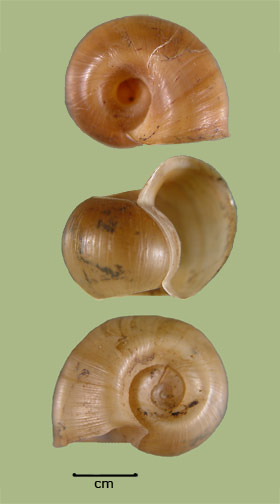> Habitat & Distribution
The
range of H. magnifica
appears to be restricted to the Cape Fear River drainage in the
vicinity of Wilmington, NC. Early records were only from the
lower Cape Fear River and from Greenfield Lake (Bartsch 1908, Baker
1945), both of which have been environmentally degraded in recent
years. There was concern that H.
magnifica
was extinct until the 1986 and 1993  discoveries of
populations in Orton
and Sandhill Creek Ponds, respectively (Adams and Gerberich 1988, SCFTM
1990, Adams and Brady 1995). Helisoma magnifica
is rare in our 17-state study area, FWGNA incidence rank I-1.
discoveries of
populations in Orton
and Sandhill Creek Ponds, respectively (Adams and Gerberich 1988, SCFTM
1990, Adams and Brady 1995). Helisoma magnifica
is rare in our 17-state study area, FWGNA incidence rank I-1.
> Ecology & Life History
Helisoma magnifica appears to be restricted to sheltered regions of lentic environments with diverse aquatic vegetation (SCFTM 1990). In Orton Pond, individual snails were typically collected from the stems and leaves of floating plants growing above a benthic substratum dominated by decomposing plant material (Adams and Gerberich 1988).
> Taxonomy & Systematics
Some question has been raised regarding ecophenotypic
components to the very large body size by which H. magnifica
has been distinguished. See my essay of 29Nov04 below.
But
The CO1 sequence data of Bogan et al. (2003) suggested that H. magnifica
is phylogenetically distinct from a variety of other planorbids
inhabiting the eastern United States, with a minimum sequence
divergence of 4.6% to the most similar taxon, H. trivolvis.
The classification of the Planorbidae proposed by the tag team of Baker
(1945) and Hubendick (1955) remains, after 50 years, the basis for our
understanding of this large and diverse family of pulmonates
worldwide. Burch followed Taylor (1966) in promoting Baker's
subgenus Planorbella
to generic rank and moving magnifica
into it, but we disagree, for reasons elaborated in my essay of
11Apr08, accessible below.
> Maps and Supplementary Resources
> Essays
- Helisoma magnifica figured prominently in my essay of 29Nov04, Gigantic Pulmonates. That post also features a scan of the H. magnifica plate from Baker (1945).
- See my post to the FWGNA blog of 11Apr08 for a review of the Classification of the Planorbidae.
- Or view the (Hubendick 1955) classification of North American planorbids in a tabular format [here].
- See my post of 26Sept14 for good, comparative figures illustrating "The egg masses of freshwater pulmonate snails."
> References
Adams, W.F., and A.G. Gerberich.
1988. Rediscovery of Planorbella
magnifica Pilsbry in southeastern North Carolina USA.
Nautilus 102:125-126.
Adams, W.F., and S.G.
Brady. 1995. Rediscovery of the aquatic gastropod Helisoma eucosmium
(Bartsch, 1908), (Basommatophora: Planorbidae). Brimleyana
22:23-29.
Baker, F.C. 1945.
The Molluscan Family Planorbidae. The University of Illinois Press.
Urbana, Illinois.
Bartsch, P. 1908.
Notes on the fresh-water mollusk (Planorbis
magnificus) and descriptions of two new forms of the same
genus from the southern states. Proc. US Nat. Mus. 33:
697-700.
Bogan, A. E., M. R. Raley and J. F. Levine (2003)
Final report on the taxonomic status of the Greenfield ramshorn, Helisoma eucosmium
(Bartsch, 1908) and the magnificent ramshorn, Planorbella magnifica
(Pilsbry 1903) (Mollusca, Gastropoda, Planorbidae) from eastern North
Carolina. Unpublished report filed with the US Fish &
Wildlife Service, Asheville. 22 pp.
Hubendick, B.
(1955)
Phylogeny in the Planorbidae. Trans. Zool. Soc. London 28:
453-542.
Scientific Council on
Freshwater and Terrestrial
Mollusks. 1990. (W. F. Adams, Chair) A report on the
conservation
status of North Carolina s freshwater and terrestrial molluscan
fauna.
Taylor, D. W. (1966)
Summary of North American Blancan nonmarine mollusks.
Malacologia 4: 1 - 172.








